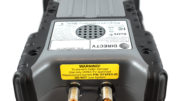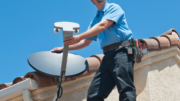QAM. Most likely you think it’s either an unpronounceable random set of letters or an Australian airline. In both cases you would be wrong. It stands for Quadrature Amplitude Modulation. That’s a fancy way of saying that unlike AM or FM which have one waveform, QAM has two and that makes it much more efficient. It means that HD channels can fit into much smaller spaces.
Why should I care about QAM?
QAM is used by cablesystems and also by DIRECTV in their COM3000 system. It’s also used in standalone headend systems such as those used in hotels and restaurants. Using QAM technology allows for systems like these to carry well over 100 channels in high definition, in a set of frequencies that should really only hold about 50 channels. There’s a dirty little secret to QAM, though… it’s not all the same. A single QAM channel carries 38.8 megabits of information, but that full amount is never used for just one channel. If it was, you could carry Blu-ray-quality video and audio over cable, but then you would probably get maybe 20 channels. That chunk of bandwidth is sliced up so that it’s used most effectively. Often times, you’ll see channels with very little movement (like shopping channels) get a small amount of bandwidth while sports channels get a lot of bandwidth.
The wrong way to use QAM
Cable companies will try to fit as many as 8 HD channels on one QAM channel. That means the quality is generally worse than what you see on low-quality streaming . They do it through techniques like bitstarving and gamut compression that strip quality out of the signal while still letting the cable company call it “HD.” The more channels they want to have, the more channels they shove into a single QAM. Over the years, this has been one of the real complaints about cable companies and the product that they deliver.
More modern systems from Xfinity and Spectrum operate using pure IP video, meaning there’s very little technical difference between “cable TV” and “streaming.” This does allow for better quality if the cable system chooses to do it that way. Most of the time they don’t.
Using QAM the right way
On the other hand, DIRECTV’s COM3000 system puts only two HD channels on one QAM, which gives each channel the same quality that regular DIRECTV boxes put out. DIRECTV systems are also capable of putting 4K over QAM in their COM3000 systems. This means clearer sharper images and none of the shenanigans that the cable companies use. It’s a little more expensive to do it that way but the results speak for themselves.
Even traditional headends tend to have better quality than what you see on cable television. Most headend systems use encoders that allow for between 2 and 4 channels on each QAM. Modern encoding technology means that it’s very possible to get good quality out of these systems. If you’ve been disappointed in what you’ve seen in headends before, you owe it to yourself to look at what can be done now.
Consult the QAM experts
The enterprise team at Signal Connect is here to help! We have decades of experience with commercial headend systems. Our team can plan the perfect system for you and make sure that it’s properly installed. Often times our COM3000 systems come ready to install. Just put them in place of an older headend. All you have to do is disconnect one wire from your old system and connect up the COM3000. It’s that easy.
Are you ready to find out more? Of course! So, now’s the time to call the experts. Signal Connect’s team is here for you. Call us at 888-233-7563 during East Coast business hours. We’ll make sure you get unparalleled customer service. If it’s after hours, no problem! Fill out the form below. We’ll get right back to you!





